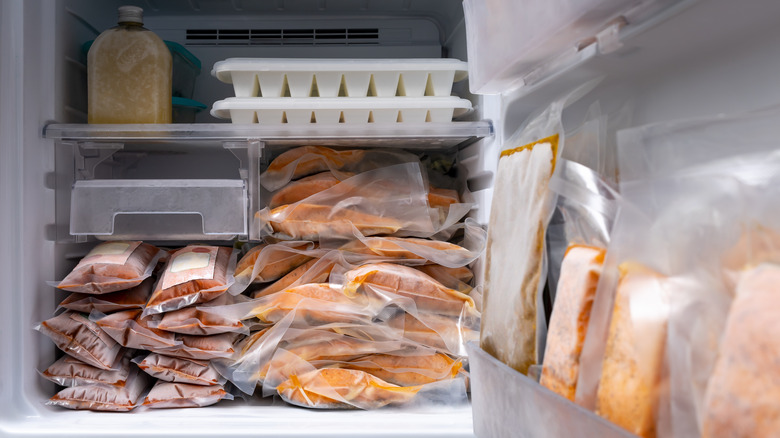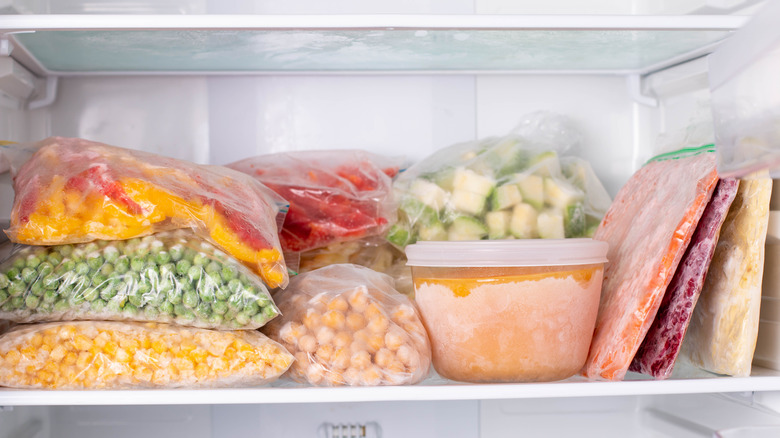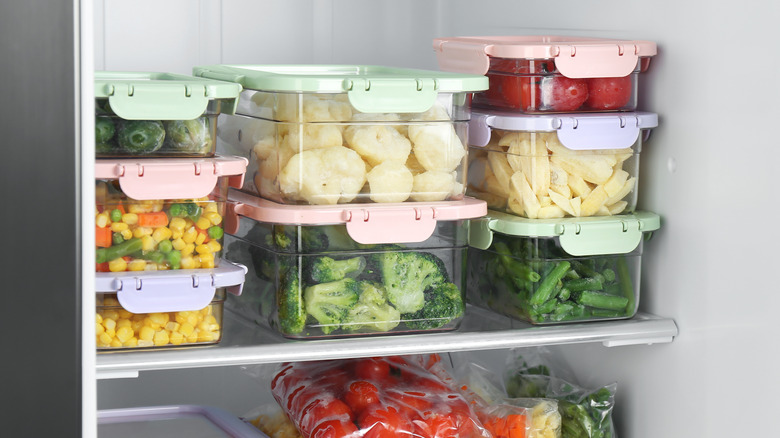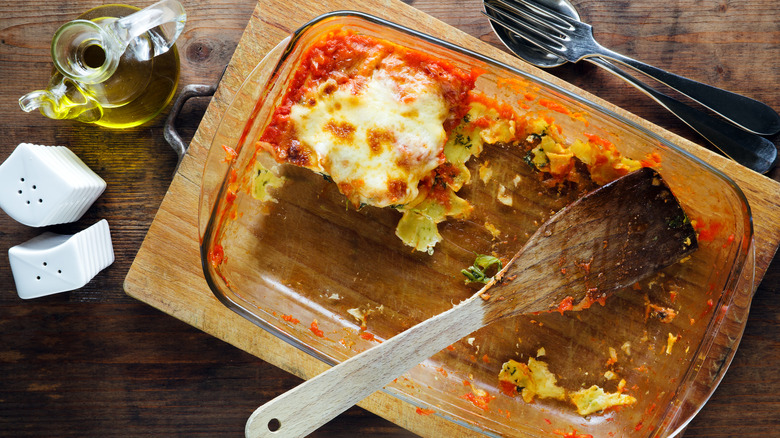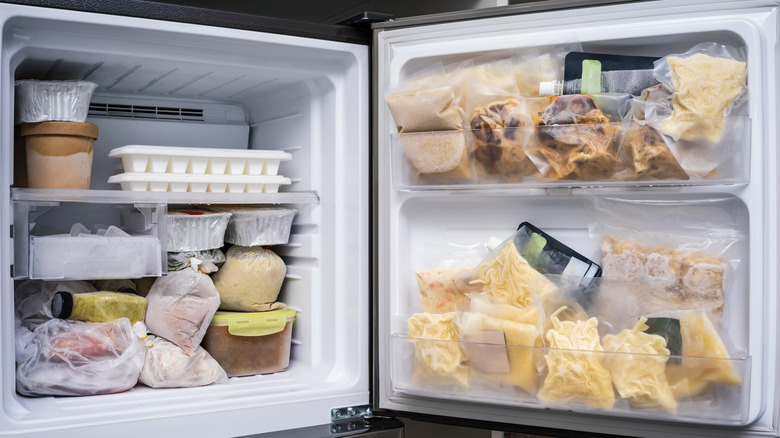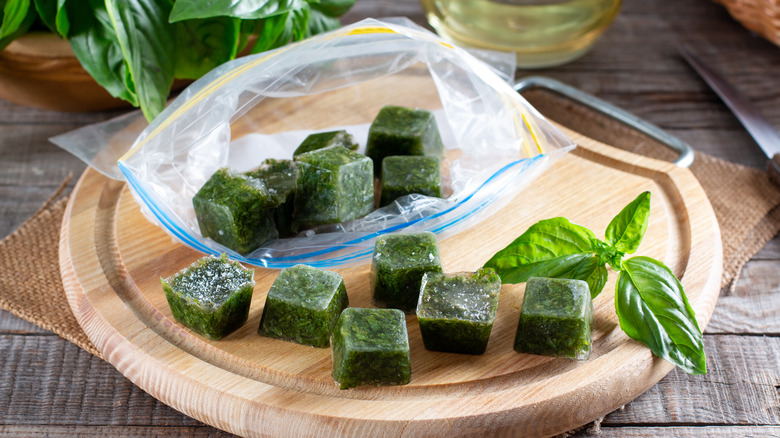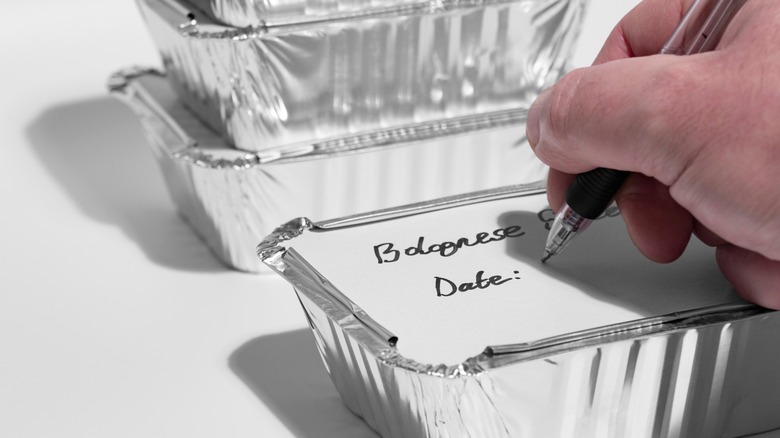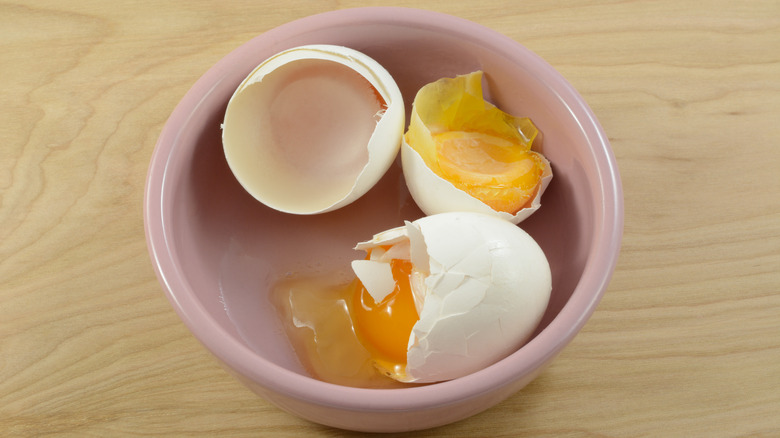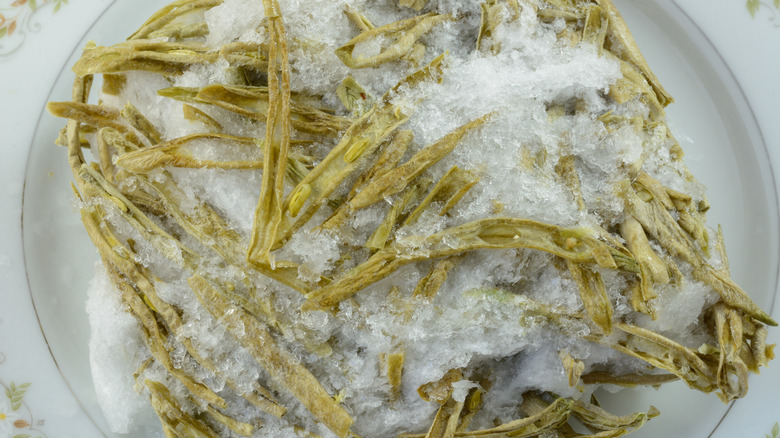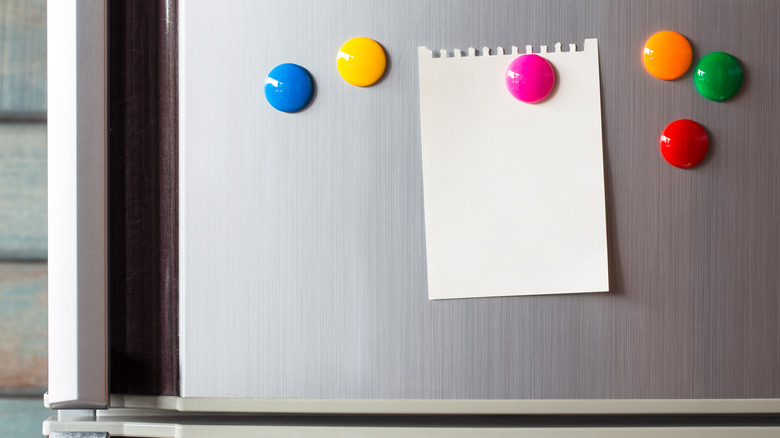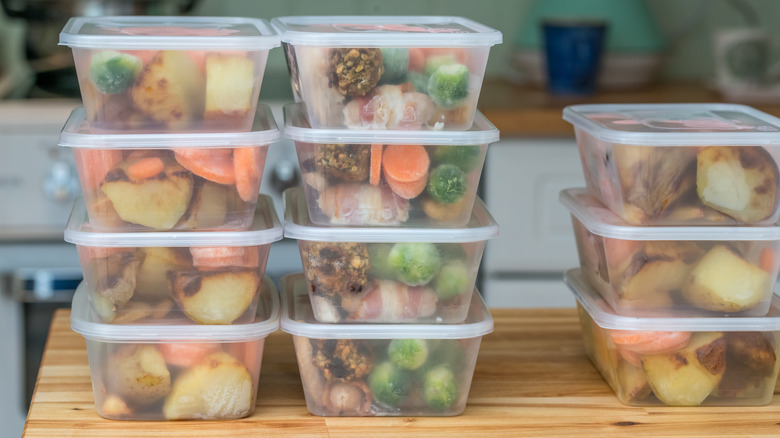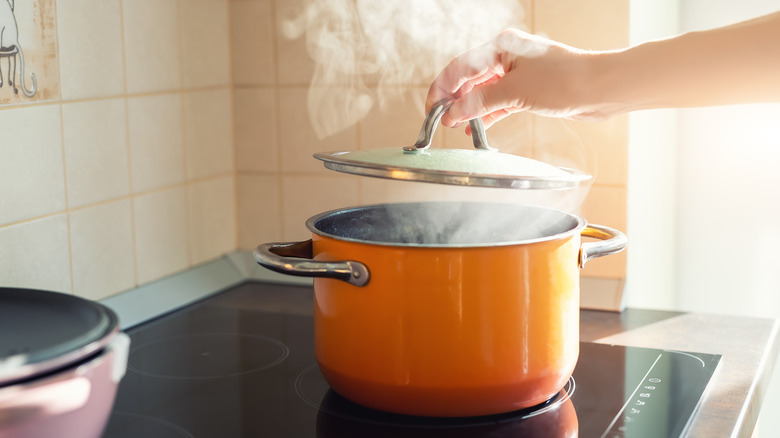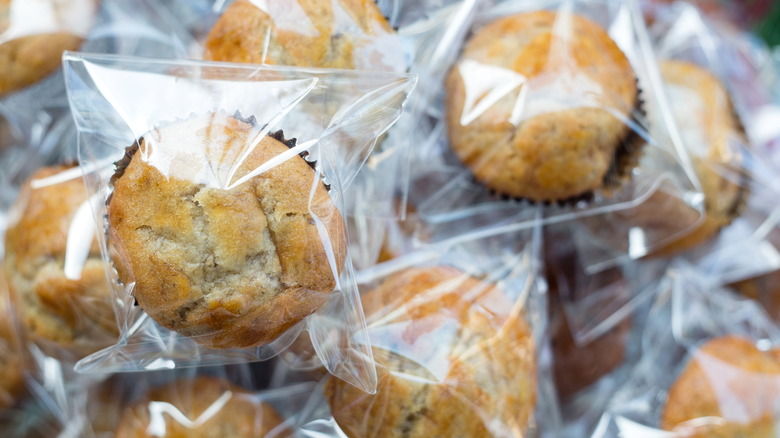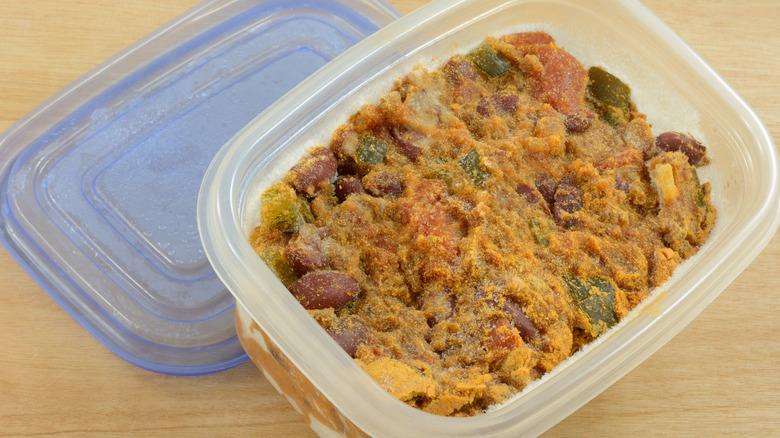The 13 Biggest Mistakes You're Making When Freezing Leftovers
There's nothing worse than getting home late from work, exhausted, only to discover that your refrigerator is empty. Half a container of orange juice and some wilted spinach just won't do. Although any excuse to order takeout is welcomed, it may be time to start thinking ahead and freezing your leftovers so that you always have a quick grab-and-go option. However, it is very important to freeze your leftovers the right way so they are safe, flavorful, and just as desirable as the day you made them.
While you may be tempted to throw that leftover lasagna or cream of mushroom soup in some flimsy Tupperware and shove it in the back of the freezer, it's best to take a few safety precautions. In addition, it's important that your food continues to appear desirable to you and keeps the incredible flavor you worked so hard to create. If you're being honest with yourself, how often have you thrown out frozen leftovers just because they looked a little iffy or were crusted with ice crystals? How many times did you throw out unidentifiable frozen mystery food? Waste no more! Let's talk about the biggest mistakes you're making when freezing leftovers so we can avoid them altogether.
Not being space efficient
It's easy to end up with a freezer stacked to the brim with leftovers, produce, meats, and frozen dinners. There's a reason you have several bags of open frozen peas lurking in the shadows. But let's be real: You're never going to sift through the mess and make your way to the leftovers of yesteryear until it's time to throw them out. This is why it is so important to keep your freezer organized — and it all starts with using your space wisely.
The best way to save space in the freezer is by using small freezer bags to store soups and other high-liquid-content meals. Fill your baggie with a single portion of food, squeeze the air out, and lay it flat in the freezer until it becomes solid. Repeat the process until you have frozen all of your leftovers. Then, stack them on their sides, like books on a shelf. This way, they will freeze faster, be easy to fan through, and take up little space.
Using the wrong containers
First and foremost, it's always a good idea to follow safety protocols by checking to ensure that your glass, silicone, or plastic food storage receptacles are freezer-safe. It's also critical to use only containers with tight-fitting lids. The goal is to reduce the airflow that comes in contact with the leftovers to decrease the chances of freezer burn.
In addition, consider which shape storage containers are best. Try using a shallow one so that your leftovers can freeze quickly. They are also easily stackable and help keep your freezer tidy and organized. If you use a deep container, it will take a significant amount of time for the center to become fully frozen, which leaves a window for bacteria to grow.
Avoid using flimsy containers, or those with loose lids, or are not freezer safe to prevent unwanted bacteria and chemicals from leaching into your food.
Waiting too long to freeze them
Even if food is stored safely in your refrigerator, it will continue to grow bacteria. By sealing it tight and keeping it below 40 degrees, though it's not entirely preventable, bacteria will grow much slower. That's why it's so important to freeze leftovers as soon as they have cooled for the first time.
For instance, if you've made a large pot of soup or a casserole, section out several portions for you or your family. Enjoy them with dinner; once the dish has cooled for a few hours, proactively store some of it in the refrigerator and then the rest in the freezer. Even if you think you may want to enjoy it all in a few days, it's better to freeze now and defrost it later than wait until bacteria take over to freeze it. This does take some thinking ahead and timeline organization, but you know better than anyone else how many days in a row you can tolerate leftovers. If you think you can't finish the entire portion in three days, freeze the rest right after it's cooled. Never freeze foods that are on the brink of spoiling. The sooner, the better!
Overpacking your freezer
Although kitchen organization is aesthetically appealing inside and outside your freezer, it also has a practical purpose. Your crammed freezer isn't getting the air circulation it needs, and your leftovers are in danger of thawing and refreezing. Each time food follows this cycle, there is a window for new bacteria to grow. In addition, multiple freezings can cause leftovers to break down and lose flavor. All in all, the quality of the meal drops drastically.
Instead of packing food in as tightly as possible, devise an organizing strategy. Try to freeze your most recent meals in the dark depths of the freezer and bring older creations to the front, as you will likely eat them sooner. This is also a good way to remind yourself of what you have on hand that needs to be eaten. Also, pack your fresh, unfrozen food away from your already-frozen meals; this will allow space for air circulation and give your leftovers room to freeze faster.
Failing to utilize kitchen gadgets
At this point in life, you've probably used a wine bottle as a rolling pin, a hardboiled egg slicer to cut baby bella mushrooms, and anything you can get your hands on with holes in it to strain pasta. We are innovative and scrappy when we need to be, so let's put all of those kitchen gadgets to use to freeze our leftovers.
If you live alone, then you can appreciate the importance of single-serve freezer meals. Try freezing your single-serve portions in muffin tins. Liquid-dense foods like soup work well. Simply ladle the room temperature or chilled soup into oiled muffin tins, wait for it to freeze, and pop them free — like you would with ice in an ice cube tray — into a freezer bag. When you're ready for a quick dinner, grab a few frozen muffin-shaped soup balls, defrost them, and enjoy single-serve leftovers without using an ice pick.
Similarly, consider using ice cube trays for smaller portion dishes, soup starters, herbs, or tomato paste. For herbs, freeze them with a liquid like water, vegetable broth, or olive oil.
Not thoroughly labeling containers
You don't have to be type A to understand the importance of labeling frozen meals. And if you've never thrown out a container of frozen food because you just didn't know what the heck it was, then you're one of the lucky ones. Properly labeling frozen leftovers can save you time, money, and sanity.
Each container or baggie should be labeled with the item's name, the date it was made, the date it was frozen, and any top allergens like nuts, eggs, or gluten. While that last label may seem like overkill, it can save you from dangerous speculation down the road when your dinner guest declares their allergy or your kid makes a new friend, and they raid the freezer. By labeling each dish with the date, you can be secure in knowing that you're in the safe zone and that your leftovers have not spoiled before you risk your stomach or those of your family. Write your labels on the top and the side of the Tupperware to avoid rearranging and removing unnecessary items from the freezer just to check what it is.
The next step would be to go through the freezer every once in a while and throw out anything that's been there for over three months or beyond its expiration date. Although some foods last longer than others, the three-month rule is fairly universal.
Freezing the wrong foods
Have you ever defrosted leftovers only to find a mealy glob of unrecognizable jelly on your plate? Some items just aren't meant to be frozen because ice crystals break down their composition too much, and some leftovers can even become dangerous to eat by doing just that.
There are quite a few foods you're likely storing in the freezer that you shouldn't. For starters, anything containing cornstarch, typically used as a gluten-free thickener in soups, stews, and sauces, thaws from its frozen state horribly. Use flour, agar agar, or arrowroot instead, or wait to add the thickener until after the dish has been defrosted. In addition, leftover egg whites can become tough and rubbery, and dairy products like milk, yogurt, and cheese are likely to separate. Potatoes are another unlikely leftover that has a difficult time with thawing. They become mealy unless they've been flash-frozen. Lastly, we recommend avoiding freezing your raw vegetables until you plan to blend them up in a sauce or don't mind a mushy texture. Veggies are mostly water; once their structure breaks down during the thawing process, they can become limp. Try blanching vegetables before freezing them to help them keep their form.
Waiting too long to defrost them
While we'd all like to think that the freezer is a magical box that preserves leftovers forever, that is simply not the case. As noted, freezing, like refrigeration, slows the growth of bacteria but doesn't stop the process altogether. Per FoodSafety.gov, certain food items can last up to half a year, while others take little time to spoil.
The earlier leftovers are frozen after being made, the better their chance of making it in the freezer. In addition, foods stored in the back are less likely to be introduced to warm air when the freezer opens, so they stay the most thoroughly frozen; this allows them to last longer.
But all of this is to say that there is certainly a cutoff for the time your leftovers should be in the freezer. Most cooked meats can last up to four months, while soups and chilis can last up to six months. However, the average food typically lasts about three months, so if you have any questions about whether something is fresh, refrain from exceeding the three-month mark.
Being unorganized
If you don't know what's hiding in the depths of your freezer, you'll likely forget about it. And there's no shame in that; we've all been there. Months have passed, and you've spent plenty of evenings wishing you had a quick and easy dinner at your disposal. As it turns out, a single serving of lasagna was hidden in your freezer this whole time. If only you had remembered! Forget no more.
Keep a list outside your freezer detailing all your leftovers, so you never miss a beat. Mark the date it was frozen, how many portions are in there, and the dish's name. Every time you eat a meal, update your chart and cross out any food you've already enjoyed. This simple habit will keep you from wasting leftovers ever again. In addition, once your freezer items reach their three-month mark, you'll know exactly what to throw out.
Not thinking ahead
After having carrot ginger soup for three lunches in a row, you may be sick and tired of looking at it. Time to pop it in the freezer and forget about it for a few months! Most of the time, when we store leftovers, we are just trying to get them out of our hair for the time being, and we often forget to look ahead. Consider the defrosting experience before you divvy up your food to store in the freezer for later.
Keep meals small. If you live alone, consider always freezing leftovers in single portions. Better yet, keep full meals together. Remember TV dinners? Frozen, portioned-out spreads containing an entree, a few side dishes, and sometimes even dessert is incredibly convenient. Grab some freezable containers with separate sections, and do a little meal prepping every time you store leftovers. For example, if you have extra lasagna, throw it in your "TV dinner tray" with a few sides, like blanched green beans or steamed carrots.
However, it's also worth noting that you should only freeze multiple foods together in a container if you plan on finishing it all within a few days of defrosting — or if you're ready to compromise the rest of your frozen meal. Your future self will thank you.
Not waiting for your food to cool
Although it's best to freeze food as soon as it is made to prevent the growth of bacteria, it's just as important to let those leftovers cool before taking action. It might be tempting to throw them in the freezer after they come fresh out of the oven or off the stovetop. Not only does this heat up the freezer, risking the expiration of already-frozen goods, but it also increases the amount of condensation, which can leave your food with ice crystals.
Stop putting warm food directly in the freezer and let it cool down to at least room temperature. Better yet, let it cool and transfer it to your refrigerator first to chill even more before adding it to the freezer.
Also note that the more room-temperature food you put into your freezer, the more likely it is to raise the temperature around it. So, if you have several leftovers, freeze one meal daily to space them out.
Only using one layer of wrap
Who knew that there was such an art to freezing leftovers? While throwing a layer of plastic wrap on a leftover brownie or some muffins may seem like a good idea, it may not be enough protection. Baked goods, among other foods, can still be quite tasty when defrosted if you wrap them correctly. For example, with goods like muffins, you should always use two layers of wrapping. Use plastic wrap for the first layer to trap moisture in foods and then aluminum foil on the outside to reduce freezer burn.
If you prefer a freezable baggie, consider wrapping the foods in plastic wrap or wax paper to reduce air exposure first. Even for soups and other leftovers stored in containers, an added layer of plastic wrap over the top can reduce the chances of freezer burn and the buildup of ice crystals. Enjoy moist, leftover goods without that freezer taste.
Reheating too many times
When it comes to defrosting and reheating leftovers, we recommend only doing this once. Each time you let a freezer meal thaw out, it has the chance to grow bacteria, and its structure breaks down. If this happens multiple times, you increase the chances of having a buildup of bacteria in your food that may change the flavor and cause intestinal discomfort and even foodborne illness.
If you cook a large portion of food and know you won't be able to eat it all within a few days, freeze it in single-serving portions. Furthermore, when reheating the refrigerator items, we suggest only reheating the amount you plan on eating right away instead of throwing the whole tray of lasagna back in the oven or the entire pot of soup on the stovetop.
Keep your already-frozen goods in single portions as well, and refrain from heating or defrosting any foods you don't intend to consume within a few days. Anything that has been frozen multiple times should be thrown away.
